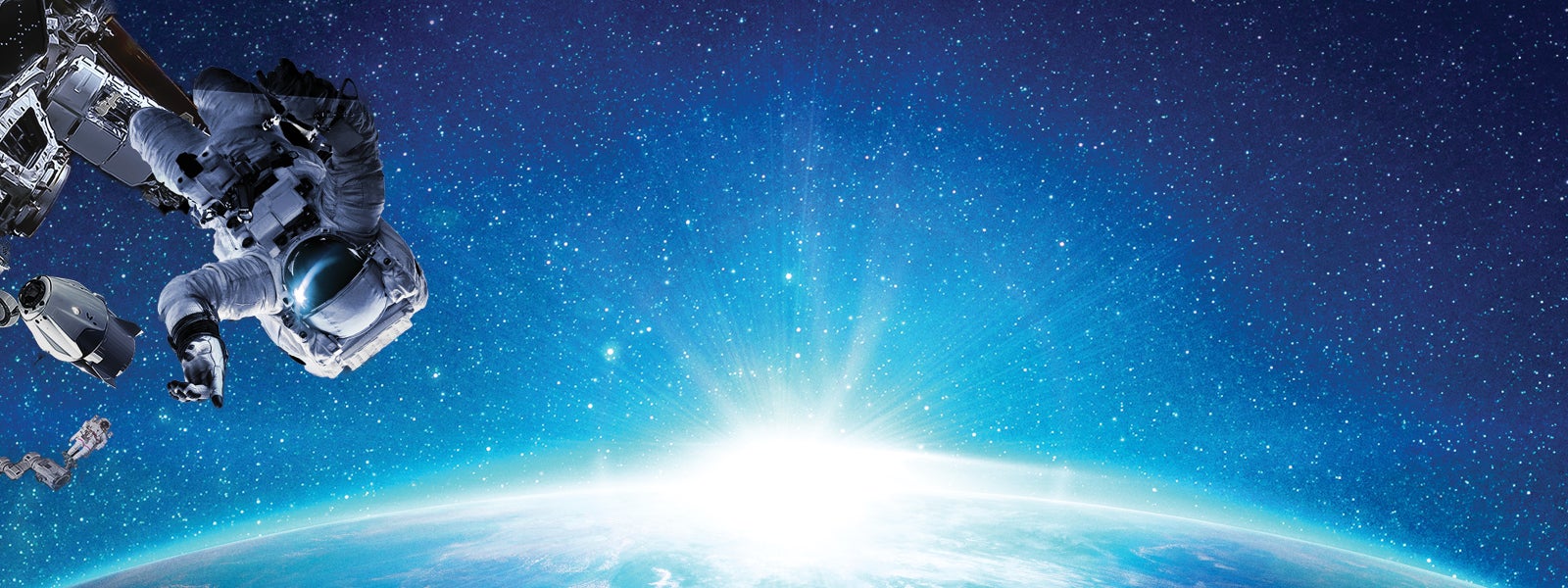
Charlotte’s Own Astronaut, Joan Higginbotham, Shares What It’s Like to Travel to Outer Space!
Outer space may sound like it’s a long way from home, but it turns out you don’t have to go far to meet a real-life astronaut. Joan Higginbotham, the third African-American woman to go into space, lives right here in Charlotte, and has graciously agreed to serve as "Honorary Ambassador" for our exciting engagement of Space Explorers: The Infinite NOW PLAYING on Stage 1 at Blume Studios, a Blumenthal Arts Experience!
Higginbotham spent nearly a decade as a rocket scientist for NASA and was actively involved in 53 different space shuttle missions, before she became an astronaut candidate herself. After years of additional training and preparation, she launched into space in December 2006.
She and a crew of six other astronauts spent nearly 13 days in space, aboard Space Shuttle Discovery. They successfully completed their mission, which focused on continuing construction of the International Space Station.
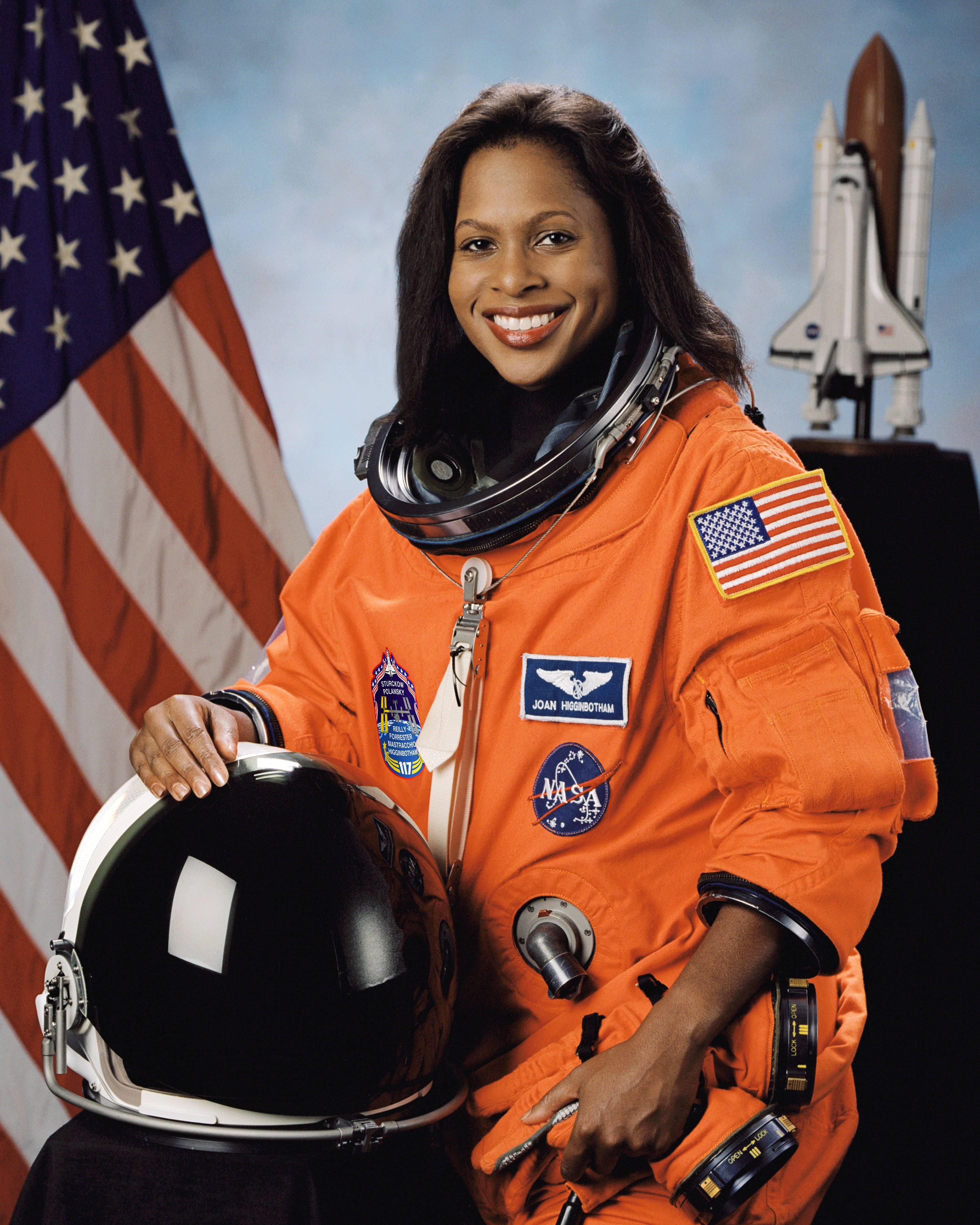
(Retired Astronaut Joan Higginbotham)
The crew engaged in four space walks, one adding another piece of hardware (the P5 truss) to the ISS, another brought a new crew member to the ISS and delivered more than two tons of needed equipment there. Higginbotham’s main role was operating the Space Station Remote Manipulator System (SSRMS), the robotic arm on the ISS.
Higginbotham spoke with Blumenthal Arts recently to talk about her journey to space, offer advice for students interested in a career with NASA or other scientific fields, and share some personal artifacts related to her mission. Those items are now on display at Blume Studios during the Charlotte run of Space Explorers: THE INFINITE, a phenomenal immersive experience featuring actual 360 cinematic video from space that makes visitors feel like they are stepping on board the ISS.
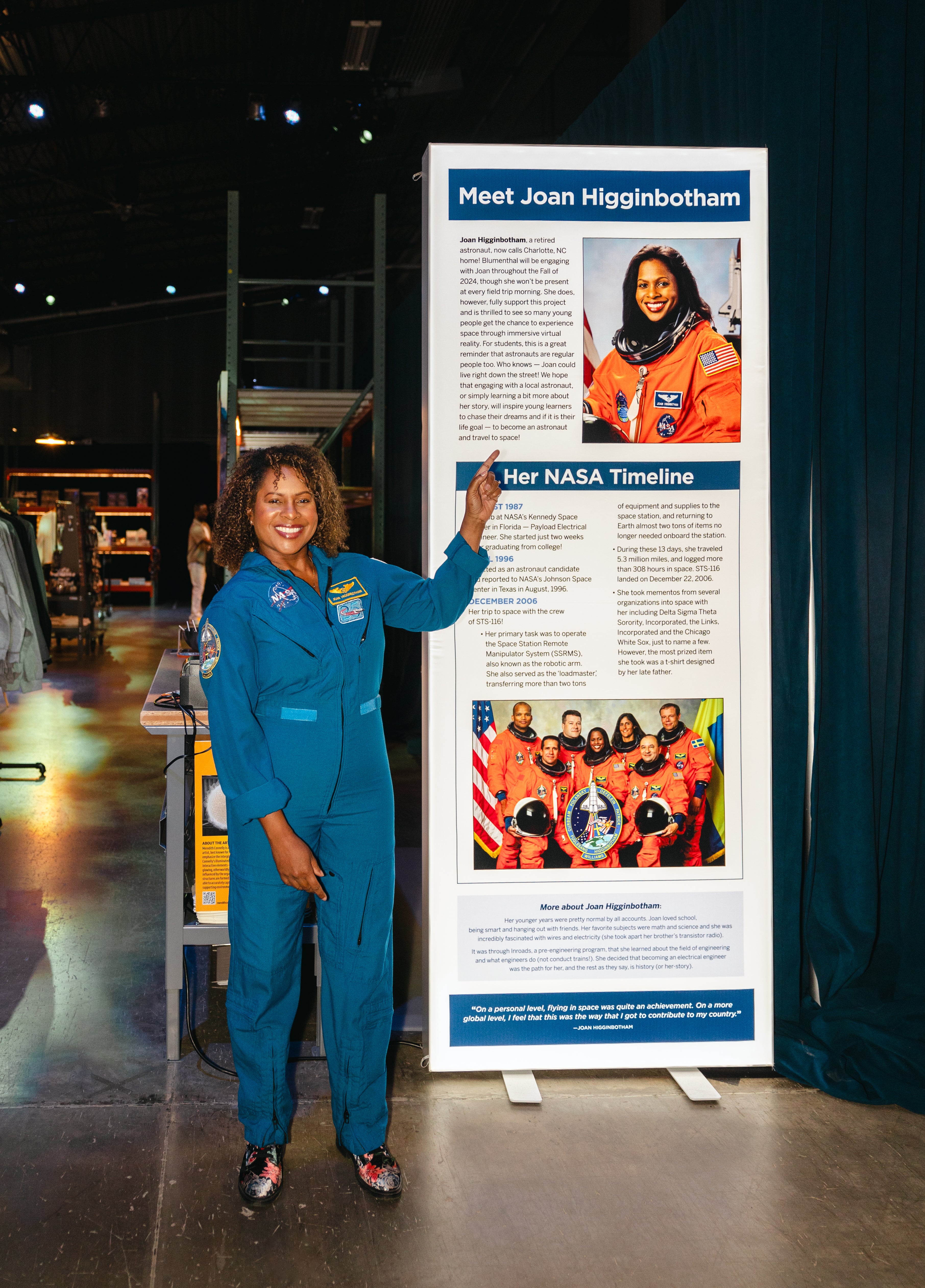
(Joan Higginbotham next to the display on Stage 1 at Blume Studios celebrating her career in space.)
Higginbotham also recorded several educational videos for area students so they can hear her first-hand account before they come in person for field trips to Blume Studios to see Space Explorers: The Infinite, as part of our “moon shot” mission to raise funds to bring 14,000 students to the space! That includes every single Charlotte-Mecklenburg Schools 6th grader – all studying earth science and space as part of their ‘24-’25 academic curriculum!
We’re about halfway to our financial goal of bringing 14,000 students to Space Explorers: The Infinite! For more information on helping us make this mission possible, visit: https://bit.ly/InfiniteStudentTicketDonation
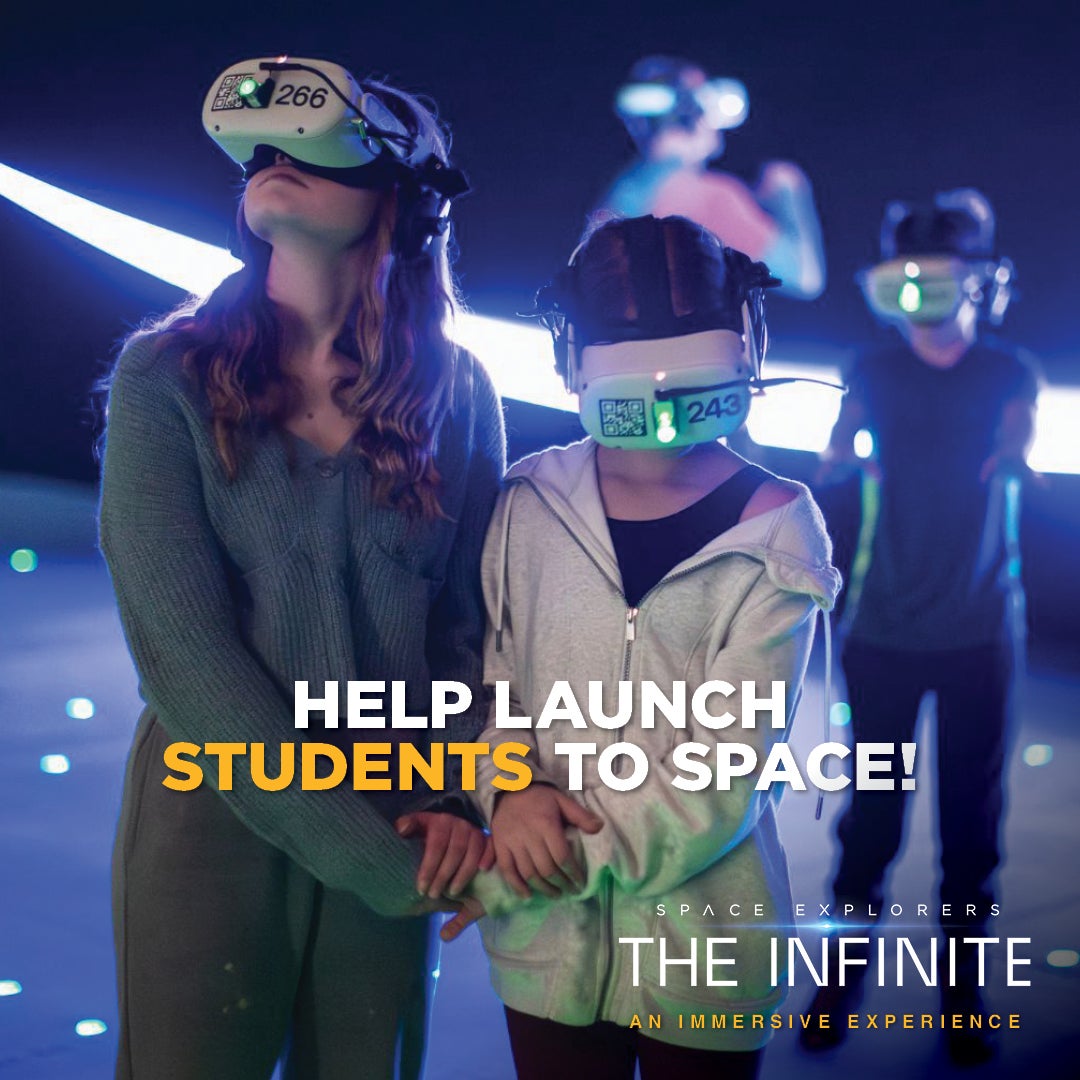
View Our Space Explorers: THE INFINITE Study Guide!
Here’s a sneak peek of what she had to say!
How she got her start
Higginbotham didn’t set out to be an astronaut. Her first dream was to become an electrical engineer. Even as a child, she was fascinated by the tools of the trade. Like the time she cracked open the back of her brother’s transistor radio to see all of the colorful wires and then decided to test what would happen if she cut them.
“That wasn’t my best engineering moment,” said Higginbotham, with a laugh.
A more successful childhood venture happened when she spotted an electrical outlet with four screws and colored wires in the den of her parents’ home. She tried hooking up an old, broken phone with wires hanging out, that her grandmother had given them. Higginbotham matched up the wires from the phone with the same colored wires on the outlet and to her delight, she got a dial tone.
“So after my parents went to bed, I'd go grab the phone and I'd wire it up and I’d call my boyfriend. Then I’d unhook it and take it back downstairs,” Higginbotham said. “And my parents, for the life of them, could not figure out why the phone bill was so high. I finally told my mother, like five years ago, that it was me who did that.”
But curiosity and ingenuity alone don’t get you to space! Higginbotham went on to pursue a Bachelor of Science degree in Electrical Engineering and holds two Master of Science degrees in Management and Space Systems.
She said academics are one of the most important parts of preparing for a career with NASA and specifically as an astronaut. “You are competing with some wicked smart people from all over the world, literally all over the world. So that is like… the floor as you're going in. Just be very, very mindful of your education.”
What does it feel like to launch into space?
Higginbotham remembers visiting Florida when she was first offered a job as an electrical engineer at NASA, right out of college. She got to see the space shuttle and the launch pads and said “it looked like something straight off the set of Star Wars.”
But years later, when she went to space, she said the first couple minutes during take off felt more like a rickety old wooden roller coaster than something futuristic.
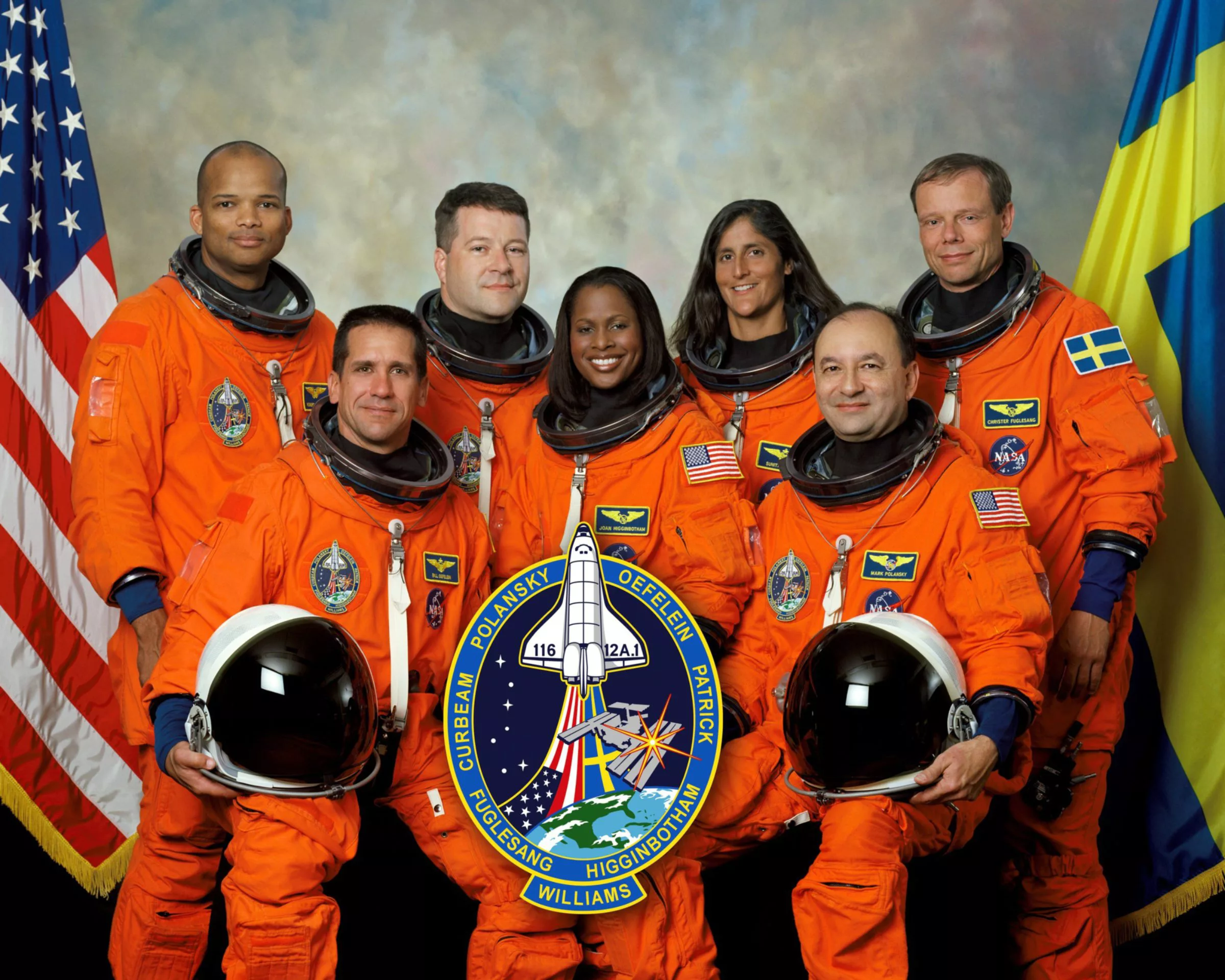
(Joan Higginbotham with the STS-116 crew who flew to space in 2006.)
“That's because you have seven million pounds of thrust that is lifting you off the launch pad,” she said. Once the rocket boosters separated and fell to the ocean (so they could be reused), the ride smoothed out. At about six minutes into the flight, she said the astronauts experienced about 3.5 times the gravitational force we have on earth.
“It feels like there's an elephant sitting on your chest,” she said. “So breathing out is very labored. You have to be very deliberate about exhaling and that lasts for about 45 seconds to a minute. And then after that, you have left earth's atmosphere and you're in space.”
Imagine that: years of preparation, about three hours strapped into the shuttle lying on your back before take-off and then it only takes eight and a half minutes of flight before the crew can unbuckle and float around the cabin!
How does it feel being weightless?
“It was sheer exhilaration,” Higginbotham said, comparing it to being in a swimming pool without any resistance. But it takes some practice to master.
“ You have no choice but to float, however finesse is required to float gracefully,” she said. “To get from one place to another, you push off from one surface and you'll keep moving until you hit another surface. So if you push off too hard, you'll go slamming into the other surface. If you don't push off hard enough, you'll get stuck in the middle of the shuttle or the space station and you have to generate a little bit of energy to get you to some other place.”
Would you believe you can eat beef enchiladas and shrimp cocktail in space?
“You eat just about any type of food that you want,” Higginbotham said. “So my commander, who was a big shrimp guy, had shrimp cocktail at every single meal — breakfast, lunch and dinner.”
Higginbotham’s favorite meal was the beef enchiladas.
But food is served up a little differently in space. There’s no refrigeration or real oven.
Almost every meal the astronauts eat in space comes either dehydrated or thermostabilized. The dehydrated foods are reconstituted at a hydration station. An astronaut sticks a needle in the package and uses it to add the required number of ounces of water and then kneads it with their hands, until it’s ready.
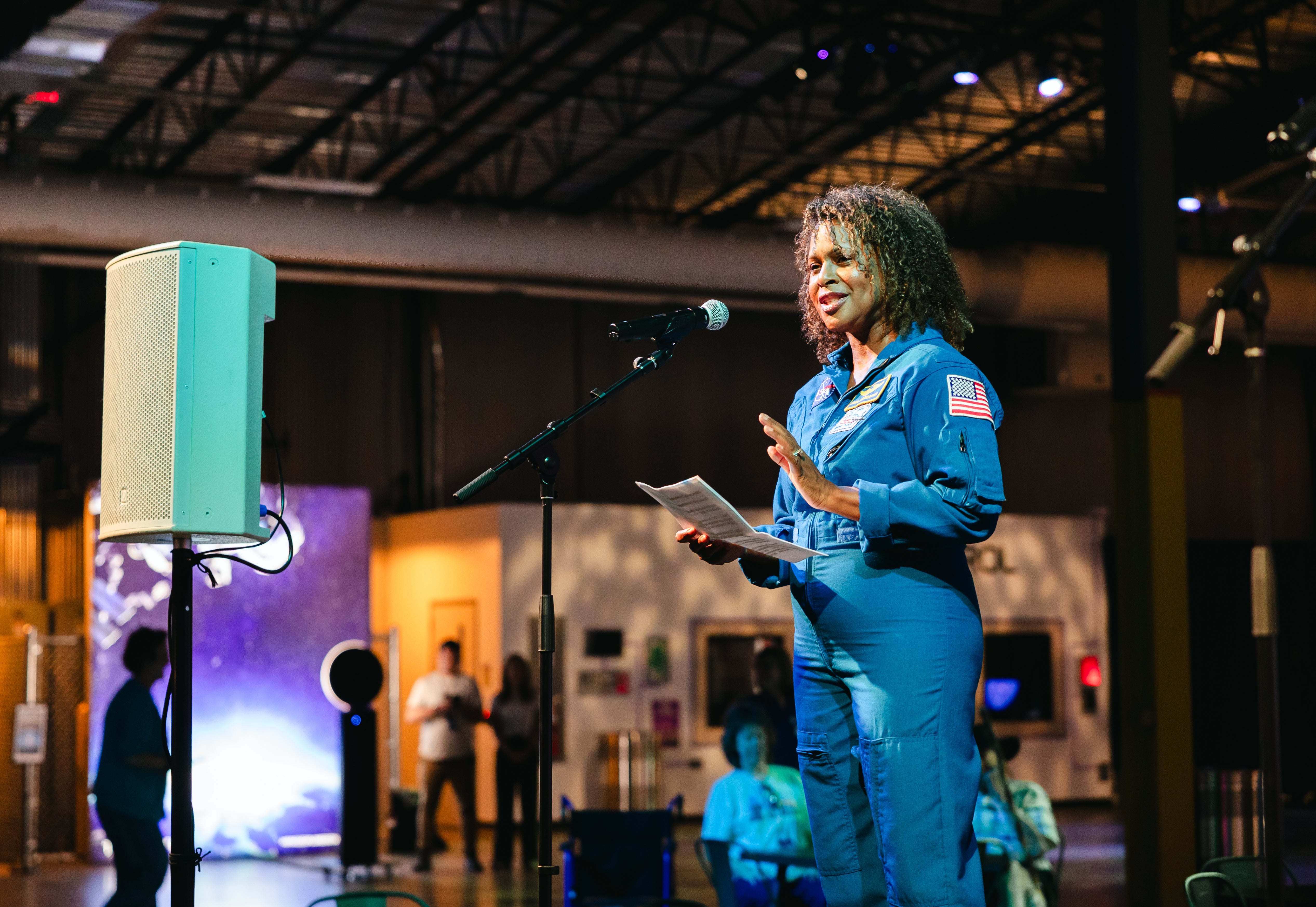
(Joan Higginbotham speaking at the Grand Opening reception for Space Explorers: The Infinite on Stage 1 at Blume Studios)
Thermostabilized foods are heated up in what Higginbotham said resembled an easy bake oven — about the size of a bread box with prongs that transfer heat to warm up food.
The little bit of fresh fruit astronauts bring has to be eaten within a few days so it doesn’t go bad. Higginbotham said she remembers when a crewmate took out an orange on the third day. It looked and smelled so good, reminding her of a Sunkist commercial where you could see the little squirt of juice come out.
“I was like, ‘Christer [Fuglesang], can I just have a couple of segments of your orange?’ That was like the best orange I've ever had in life. It just tasted so good because it was fresh.”
How fast and far did she travel while orbiting the earth?
“The shuttle and the space station travel at 17,500 miles per hour, five miles every second,” Higginbotham said. “So we're hauling, we're going pretty quick.
“And what that means is that we go around the world one time every 90 minutes. And in that 90 minutes, we get to see one sunrise, about 45 minutes and then a sunset. So if you were just to plaster yourself at the window for a full day, you would see 16 sunrises and 16 sunsets. Pretty cool.”
Because they travel so fast, they actually covered 5.3 million miles in 13 days. But Higginbotham said just like riding in a car, you can’t really feel the speed until you look out the window and see how fast you move across a land mass.
Some important lessons from space
Higginbotham said she experienced two big epiphanies in space. The first happened on the second day, when she finally got the chance to sit and look out the space shuttle’s window.
“It was the beginning of a sunrise. And at the altitude that we were flying, we could see roughly about an eighth of the curvature of the Earth and the sun just burst up over the horizon. And as it start[ed] coming up, I could see the atmosphere.”
From her vantage point, the thin blue line looked like it was only two millimeters thick — even though in reality it's much thicker than that.
It made her realize how fragile Earth is and that little bit of atmosphere is the only thing keeping us from extinction. “We need to be very mindful of how we treat Mother Earth,” she said, “because we only have one place to live right now.”
The second poignant moment came on the morning of the eighth day, when the crew finally had a little time off. Higginbotham went to the Russian segment of the space station, which had the only window at the time, to admire the Earth’s beauty and its many colors.
As they approached the Middle East, she reflected on the discord and unrest there juxtaposed with the diverse crew with which she was orbiting the earth.
“I called it the Mini-United Nations crew because we had two African-American astronauts, the first time two had flown together. Our commander was of Korean and Jewish descent. We had the first Scandinavian astronaut, he was of Norwegian and Swedish descent. We had an astronaut born in the UK who had dual citizenship, partly to realize his dream of becoming an astronaut. We had someone whose lineage was from India. We had a Spanish-American, we had a German and we had a Russian cosmonaut.
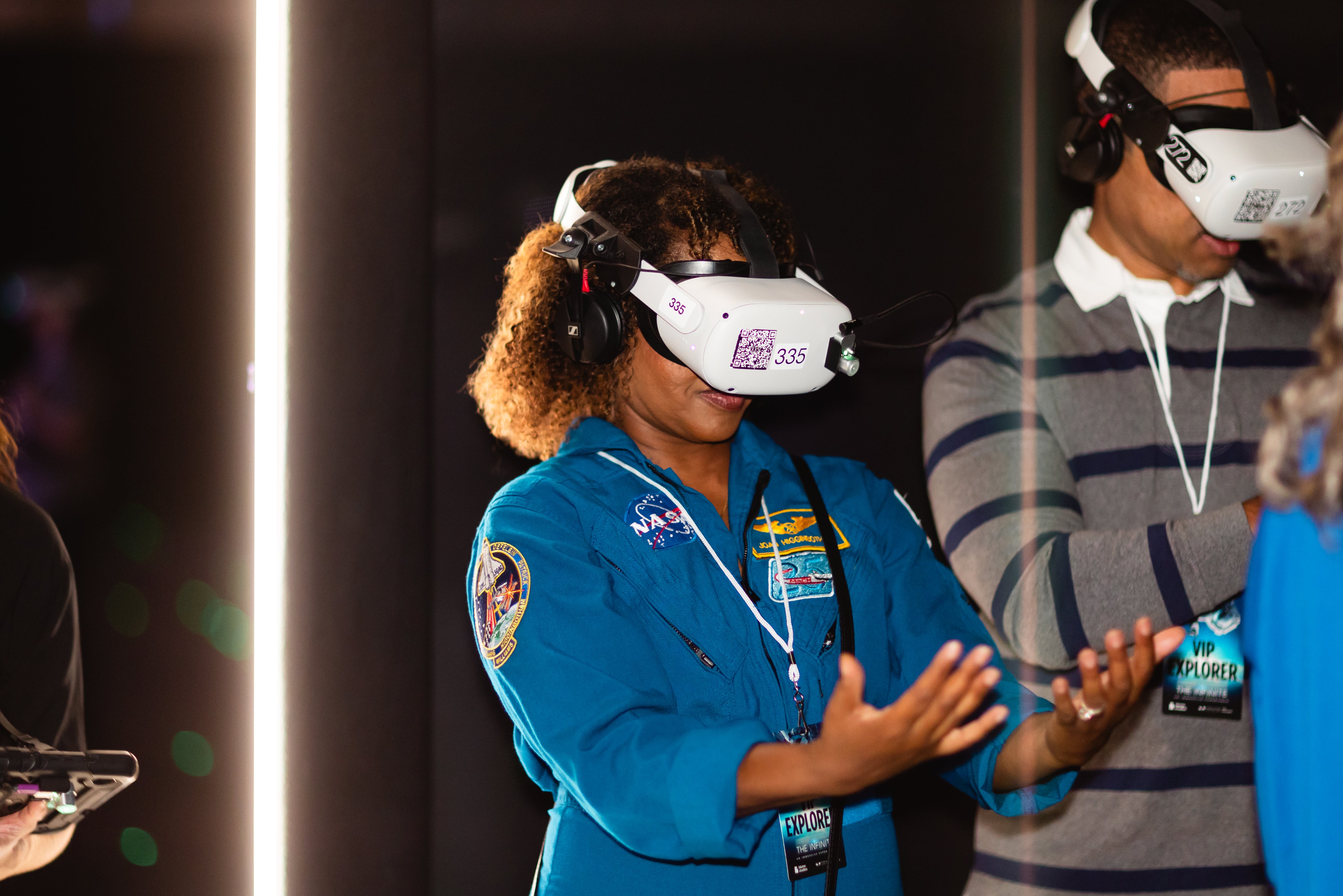
(Joan Higginbotham doing the Space Explorers: The Infinite VR experience on Stage 1 at Blume Studios)
“… And what I thought about as we were going over the Middle East is, if the 10 of us with all of our ‘differences’... could get along in this tin can of a spacecraft and work together for a common good, why can't we all do that on Earth?”
Higginbotham says that as NASA continues to look toward the future and longer durations for voyages to destinations like Mars (travel would be about 9 months just one way!), the ability for people to work well together in confined places will become even more important.
“You have to have that mentality that it's about the team,” she says, “and that's how we're going to succeed.”
Dealing with Disappointments
It wasn’t always a straightforward path for Higginbotham. The first time she applied to the astronaut program, for example, she was one of 6,000 applicants. She was among the 122 people that received an interview but not one of the final 15 selected.
Afterward, she talked to the selection board and tried to figure out what she could do to make herself a better candidate “because now the desire to become an astronaut was burning deep inside” her. She was told she needed to get more education, so that’s what she did before reapplying and being selected.
“There were a lot of disappointments on my journey,” she said. “I call them setbacks, actually. I never use the word failure because I think when you use the word failure, you have set yourself up to a point where you're never going to progress forward. That's why I say it's a setback because you can come up with a plan to move forward.
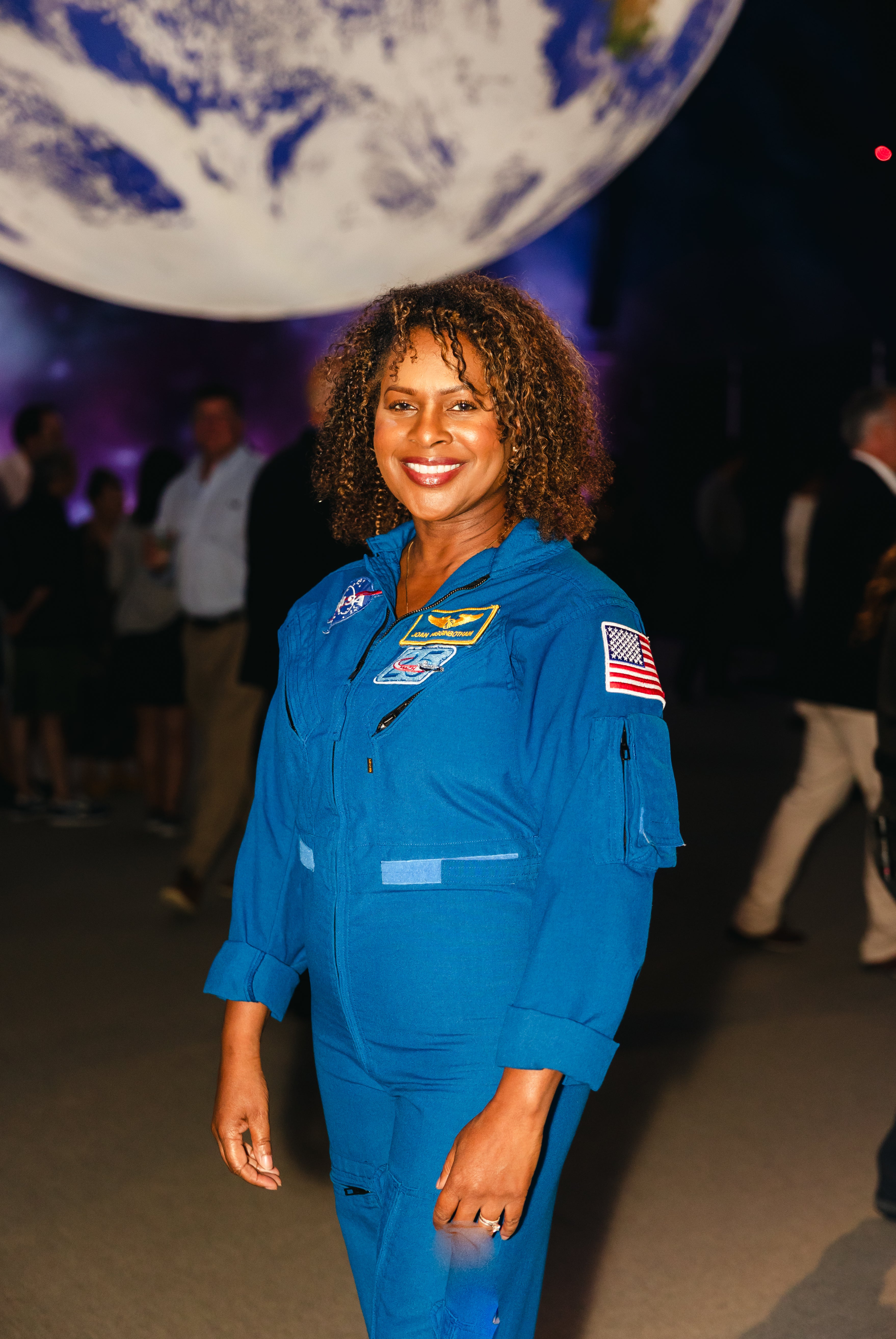
(Joan Higginbotham at Space Explorers: The Infinite on Stage 1 at Blume Studios)
“And the way I dealt with those were a couple of different ways. So there's this part of me, I call it ‘my little stubborn streak’ that when people tell me I can't do something, that's highly motivating for me and I will figure out what it takes to get it done.
“The other thing that gets me through these setbacks or disappointments from an emotional standpoint is my family, my faith, and my friends.”
Some Fun Moments
On the eighth day of the trip, the astronauts finally had some time for some fun. Someone brought a frisbee to throw. They also took turns playing with gravity, seeing who had the best aim tossing M&Ms, while someone else tried to catch them in their mouth.
“In space, things move differently,” she said. “And so normally if you drop something on Earth, it's going to go straight to the ground. In space because you're going around the Earth, things will kind of float up and then they'll start to project down.”
They also tried what Higginbotham called “stupid human tricks.” Her crew would spin her around on different axes to see how that affected the motion. “And I had my hair in a ponytail, so the ponytail was flipping around. So it was pretty cool.”
Jobs with NASA
Higginbotham says as NASA looks toward the future, they will need people from all sorts of academic backgrounds — even those outside of STEM fields — to help them reach their goals. “If you want to work in the space arena, there’s more to do than being just an astronaut,” she said. “There are the people in Mission Control. There are the people who prepare our food. There are logistics people, so there are all kinds of disciplines that support the space program.”
Want to learn more?
You can find out more about space travel and what it looks and feels like to be on the ISS by visiting “Space Explorers: THE INFINITE” OPEN NOW at the new Blume Studios! While you’re there, you can also check out some of the artifacts Higginbotham shared for the exhibit, including her NASA helmet and flight suit, a scaled model of the space shuttle, an astronaut Barbie, and a montage of images from her voyage.